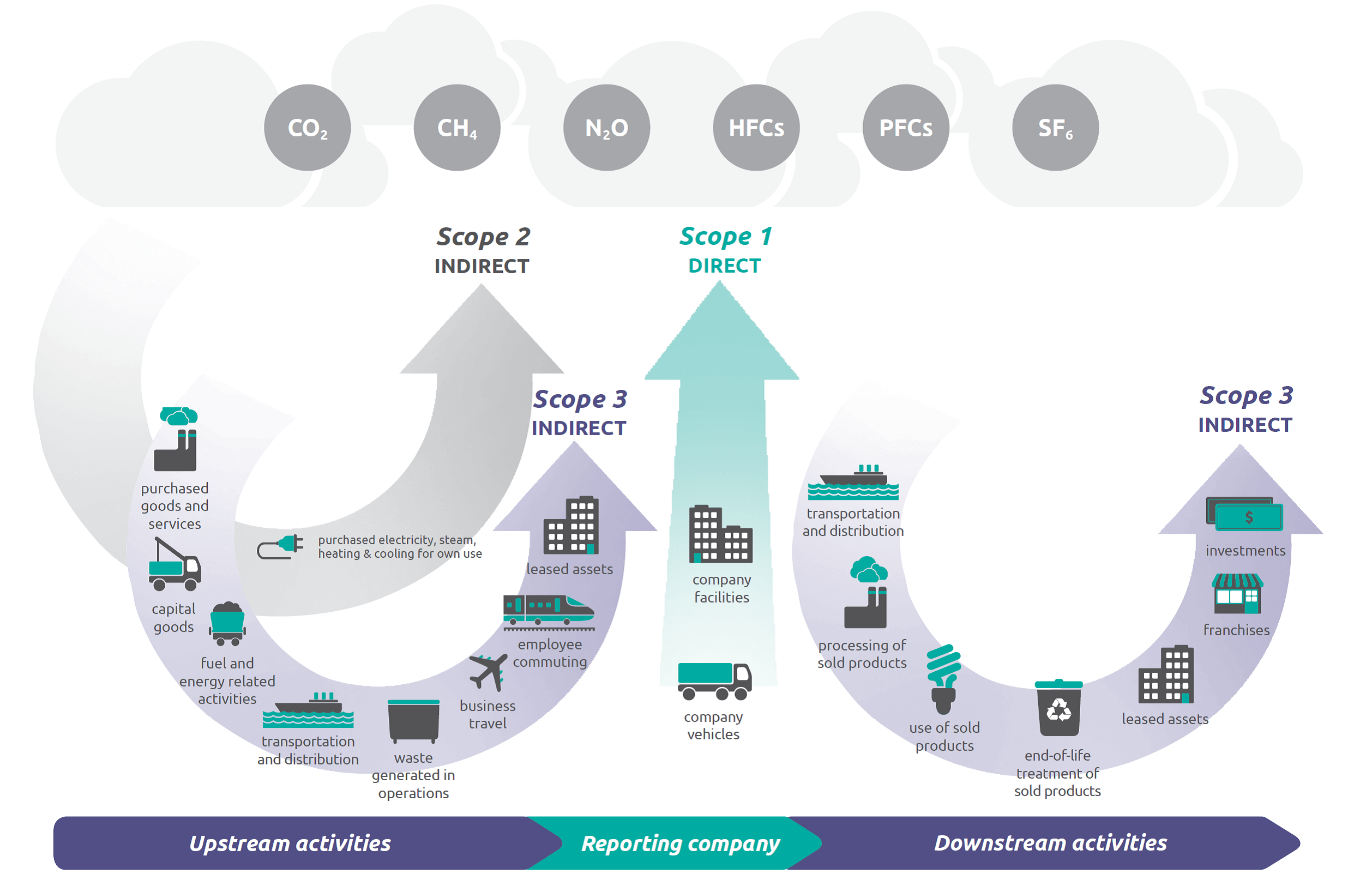
6 October 2023
Greenhouse Gas Reporting: Regulatory Context and Benefits for Businesses and Consumers
Greenhouse gas reporting has emerged as a crucial tool in today’s environmentally conscious world. Understanding and limiting the impact of greenhouse gas (GHG) emissions is not only a responsibility but also an opportunity for businesses worldwide.
This article provides an in-depth examination of the regulatory framework and the multifaceted benefits associated with greenhouse gas reporting, for both businesses and consumers. We’ll consider country-specific variations and conduct a small analysis of scope 1, 2, and 3 emissions and concerning greenhouse gasses, highlighting their relevance in our pursuit for a sustainable future.
What is Greenhouse Gas Reporting and Why is it Important?
Greenhouse gas reporting involves the systematic collection, measurement, and disclosure of an organization’s emissions, primarily carbon dioxide (CO2), methane (CH4), and nitrous oxide (N2O), which contribute to global warming.
The significance of this report cannot be overstated. It is critical in understanding an organization’s carbon footprint. This enables a precise identification of emission sources, thereby facilitating the implementation of highly targeted reduction strategies. This generated report is not just an informational document, it’s a vital tool for crafting precise and effective emission reduction plans. It examines how organizations affect the environment, providing a crucial understanding for crafting future eco-friendly plans.
In order to enhance their creditworthiness and attract potential investors, companies must carefully work towards achieving a favorable greenhouse gas rating through their comprehensive greenhouse gas reporting. Ignoring this crucial aspect could result in unfavorable loan terms or challenges in securing investments.
Scope 1, 2, and 3 Emissions in the Greenhouse Gas Context and the vital role of data
Within the domain of greenhouse gas emissions, it’s imperative to differentiate among scope 1, 2, and 3 emissions.
Scope 1 emissions encompass direct emissions resulting from assets owned or directly controlled by a company, such as emissions from the company’s vehicle fleet. In contrast, Scope 2 emissions comprise secondary emissions associated with energy purchases, such as the electricity used by the company for its operations. Finally, Scope 3 emissions extend further, encompassing emissions from the company’s supply chain and external sources.
To effectively report and reduce greenhouse gas emissions, data collection is of paramount importance. It serves as the foundation upon which informed decisions are made. However, collecting this data can present its own set of challenges. We can define two main types of data.
First we have transactional data that refers to information related to a company’s day-to-day operations. This includes data on fuel consumption, electricity usage, and the quantity of materials used. Accurate recording and monitoring of this data are essential to calculating Scope 1 and Scope 2 emissions. Second we have process activity data focused on the activities within a company that produce greenhouse gas emissions. This can range from manufacturing processes to supply chain logistics. Accurately capturing and analyzing process activity data is crucial for understanding Scope 3 emissions, as it delves into the entire value chain.
To overcome the challenges related to greenhouse gas data, we need advanced tech, stakeholder collaboration, and a strong commitment to data accuracy and transparency. These elements are essential for effectively managing and determining our carbon footprint.

Explaining Greenhouse Gas Reporting’s Role in Scope 1, 2, 3
As mentioned before, Greenhouse Gas Reporting (GHGR) involves collecting, calculating, and reporting greenhouse gas emissions categorized as Scope 1, 2, and 3.
The connection between GreenHouse Gas Reporting (GHGR) and Scope 1, 2, and 3 emissions lies in the fact that GHGR is the reporting process for these emissions. This is crucial because it enables organizations to comprehend their GHG emissions footprint and pinpoint opportunities for emission reduction. Scope 1, 2, and 3 emissions are significant as they categorize the GHG emissions that organizations can either control or influence.
To comply with regulations like the EU’s CSRD or ESG reporting, organizations must understand Scope 1, 2, and 3 emissions in greenhouse gas reporting.
The Regulatory Context in Different Countries
Eu Corporate Sustainability Reporting Directive (CSRD)
The Corporate Sustainability Reporting Directive (CSRD) is a groundbreaking European Union (EU) regulation revolutionizing corporate sustainability reporting, especially in greenhouse gas reporting. CSRD applies to ‘large undertakings,’ which include EU and non-EU subsidiaries, meeting any of the following criteria: total assets over EUR 20 million, net turnover above EUR 40 million, or 250+ employees (see the full requirements list).
These enterprises are mandated to provide comprehensive sustainability reports, a key component of which involves disclosing their greenhouse gas emissions data.
The reporting requirements under the CSRD extend well beyond mere formality. They provide in-depth insights into environmental and social aspects of business operations, underscoring the EU’s determined commitment to promoting sustainability. To underscore this commitment, the directive employs robust enforcement mechanisms, leveraging sanctions and fines to hold companies accountable for compliance, thereby marking a new era of thorough and punctual sustainability reporting in the European landscape.
Environmental, Social and Governance (ESG) – A Global Perspective
ESG, which stands for Environmental, Social, and Governance factors, is a framework employed to assess a company’s sustainability and ethical footprint. In today’s world, ESG factors have gained increasing significance, capturing the interest of investors and consumers who seek to endorse ethical and sustainable businesses. Companies with higher ESG ratings are more likely to attract investors who prioritize sustainability in their business plans, this is known as ESG investing. An integral part of ESG assessments involves taking a closer look at a company’s greenhouse gas reporting, which plays a pivotal role in evaluating its ethical and sustainable performance. Understanding how much greenhouse gas a company emits is a key factor in this comprehensive evaluation.
International Standards Organization (ISO Standards) – A Global Perspective
The International Organization for Standardization (ISO) stands as a global authority dedicated to the development and diffusion of voluntary international standards, shaping industries and practices worldwide. Within the area of environmental responsibility, ISO 14064 takes center stage.
The ISO 14064 equips organizations with comprehensive guidelines for the precise quantification and transparent reporting of their greenhouse gas emissions and removals.
Playing a central role in greenhouse gas reporting, ISO 14064 establishes a methodical framework that enables organizations to navigate the complex world of greenhouse gas reporting and encourages the use of effective and trustworthy sustainability practices.

Benefits of Greenhouse Gas Reporting
Greenhouse gas reporting enables your business to identify cost-saving opportunities through energy efficiency enhancements and waste reduction. It fosters innovation, promoting the development of sustainable products that not only make a positive impact but also penetrate into new markets. Furthermore, it enhances brand transparency, drawing in loyal customers who appreciate your environmental commitment. Additionally, it provides easier access to capital, thanks to socially responsible investors and green financing options.
But wait, there’s more! It’s not just businesses that come out as winners.
Consumers are empowered with knowledge to make eco-conscious choices, this encourages accountability and forces companies to step up their sustainability game!
By actively supporting businesses engaged in emissions reduction efforts, you’re making a significant contribution to global climate goals. Your choices have the potential to trigger a transformation in the eco-friendly product market.
Additionally, let’s not forget the impact on public health. Lowering greenhouse gas emissions isn’t just beneficial for the planet, it’s also a lifeline for improved air quality and a reduction in respiratory illnesses. So, embrace Greenhouse Gas Reporting: it presents a win-win scenario for all parties concerned.
Nurturing Sustainable Success: Uniting Greenhouse Gas Reporting and LCA Software for a Greener Future
In conclusion, greenhouse gas reporting is essential for today’s businesses. It serves a dual purpose: enabling organizations to understand and reduce their carbon footprint in compliance with regulations, while also harmonizing with worldwide sustainability efforts, such as the EU Corporate Sustainability Reporting Directive and ESG frameworks. This alignment fosters transparency, empowering consumers to make eco-friendly choices, advancing climate objectives, and enhancing public health by curtailing emissions. Embracing greenhouse gas reporting is a crucial step that benefits all stakeholders.
Additionally, through the strategic adoption of advanced SaaS solutions like Pilario, organizations can seamlessly establish a direct connection between Scope 3 greenhouse gas emissions and conducting a Life Cycle Assessment (LCA). Consequently, the outcomes from conducting an LCA can serve as valuable input for quantifying and addressing Scope 3 greenhouse gas emissions.
The integration of Life Cycle Assessment (LCA) with the measurement of Scope 3 emissions is essential in achieving a comprehensive understanding of an organization’s environmental impact. This facilitates compliance with regulatory requirements and improves overall carbon footprint management, while at the same time overcoming the data gathering issue.